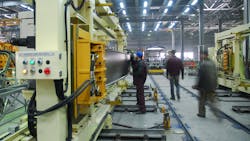Accelerate the 4P model in 2024 to develop manufacturing workforce
This article is the first of a five-part series of pieces contributed to Smart Industry that will, in the next two weeks, look ahead to digital transformation and manufacturing trends in 2024.
Also next month, please watch for SI's annual Crystal Ball Report, available to members as a downloadable e-handbook, from a group of experts who also forecast "smart" manufacturing milestones in the coming year.
One of my favorite books, whose title I say all the time, is “What Got You Here Won’t Get You There.” As someone who studies manufacturing workforce development nationally, it’s clear that what got us here won’t get us there.
Our fragmented approach to workforce development—with different policies and initiatives at the city, county, state, and federal levels—has led to winners and losers across the country, with low-income workers and under-resourced communities on the losing end in many circumstances.
See also: The Crystal Ball Report 2024: A preview podcast
Instead, we need innovative strategies to fill the 700,000-plus open manufacturing positions nationally with qualified, committed workers. To do that, my prediction for 2024 is that we’ll see a significant acceleration in the “4P” model. That means that we’ll see stronger partnerships between the three “Ps” of workforce development: the public, private, and philanthropic sectors.
Each of these sectors brings unique strengths and resources, and their renewed collaboration will address the complex challenges of modern workforce development more effectively than any single sector could alone.
The role of the public sector
Our government agencies will hopefully step up to create a more conducive policy environment. This involves crafting and implementing policies that encourage workforce development, such as tax incentives for companies investing in employee training, easier access to existing funding streams like TANF and WIOA, addressing the “benefits cliff” that hurts low-income workers, and increasing subsidies for individuals pursuing education in in-demand fields.
Governments also can provide critical infrastructure, such as quality public education systems and job training centers, which lay the groundwork for a skilled workforce. Most importantly, the public sector needs to focus on scaling what works. Our government agencies need to pay attention to the success stories, analyze the data, and then directly invest to turn individual stories into community-wide systems.
Finally, more centralization would also be welcome: we need a one-stop shop for best practices in workforce development that is available to anyone, anywhere, at basically any time.
The role of the private sector
Having been to Germany numerous times, I’ve seen their incredible alignment of the private sector and public sector firsthand. The American private sector must play a more central role in driving innovation in workforce development. With the rise of industry sector partnerships, more executives will have a seat at the table, steering regional workforce conversations with their insights and requirements.
You see, companies understand firsthand the skills required in the modern economy and are well-positioned to identify emerging job trends. But companies also must put some skin in the game by offering apprenticeships, internships, and on-the-job training programs.
See also: How smart industrial technology factors into ESSA, corporate culture
At the same time, with the rapid growth in emerging industries like electric vehicles and semiconductors, manufacturers also must invest in continuous education for their employees, ensuring that their workforce remains adept with the latest technologies and methodologies.
The philanthropic sector’s impact
As a fundraising executive for much of my career, I’ve seen the way philanthropic organizations can play a catalytic role, bringing diverse stakeholders to the table in a coordinated and thoughtful manner.
Though the public and private sectors proclaim that they value diversity, equity, and inclusion, the philanthropic foundations can keep these partners accountable by requiring engagement with underserved communities before, during, and after any new training program.
Donors—be they companies, foundations, or even individuals—can fund scholarships, research, and programs that might not offer immediate financial returns but are crucial for long-term societal benefits. Through giving with no expectation of financial gain, philanthropy can lay the groundwork for change.
Embracing technology and innovation
The same way American tech companies are always introducing new products for consumers, all three sectors should jointly embrace technology and innovation in their strategies. This includes leveraging digital platforms for training and education, using data analytics to understand workforce trends, and exploring new educational methodologies like gamified learning and virtual reality simulations.
See also: Contracted tech workers paid less than regular IT staff
Innovation also can include financial. I’ve been excited by the renewed interest in social impact bonds, which reward initial investors for the performance of training programs; pay-it-forward programs, where graduates contribute to the programs that helped them; and income-sharing agreements (ISAs), where trainees commit a percentage of their post-graduation salaries in exchange for free tuition. Put simply, financial institutions should think creatively about how they can play a role supporting exciting workforce development programs.
Adapting to rapidly changing job markets
Given the rapid pace of change in job markets, driven by factors like technological advancement and globalization, these partnerships should focus on agility and flexibility. This means creating programs that can quickly adapt to changing needs, and emphasizing skills like adaptability, problem-solving, and continuous learning in workforce development initiatives.
And when plans are thrown off by the latest world crisis, decision-making processes should be quick and easy—an ad hoc video meeting or quick email consensus is often all that’s necessary to respond in a thoughtful manner.
See also: Promoting engagement, retention in changing IT/OT workforce
What got us to this point in American workforce development won’t get us to the next stage of building an agile, dedicated workforce where employees bring their individual talents to the table.
We can address this by combining the strengths of the public, private, and philanthropic sectors, the partnership for workforce development in 2024 can create a more dynamic, skilled, and adaptable workforce. This collaborative approach is crucial for meeting the challenges of a rapidly evolving global economy and ensuring long-term economic growth and social well-being.
About the Author

Matthew Fieldman
Matthew Fieldman is executive director of America Works at MAGNET, a nationwide initiative to coordinate the American manufacturing industry's training efforts. Fieldman’s America Works promotes collaboration, efficiency, and impact of local and regional workforce development efforts. America Works is part of the MEP National Network.

